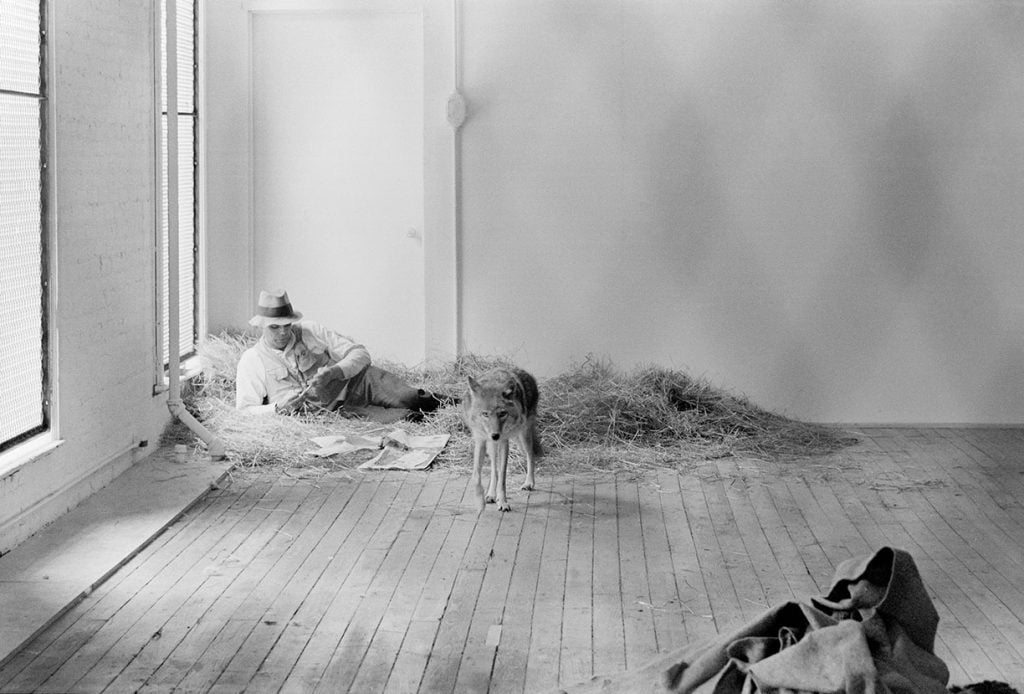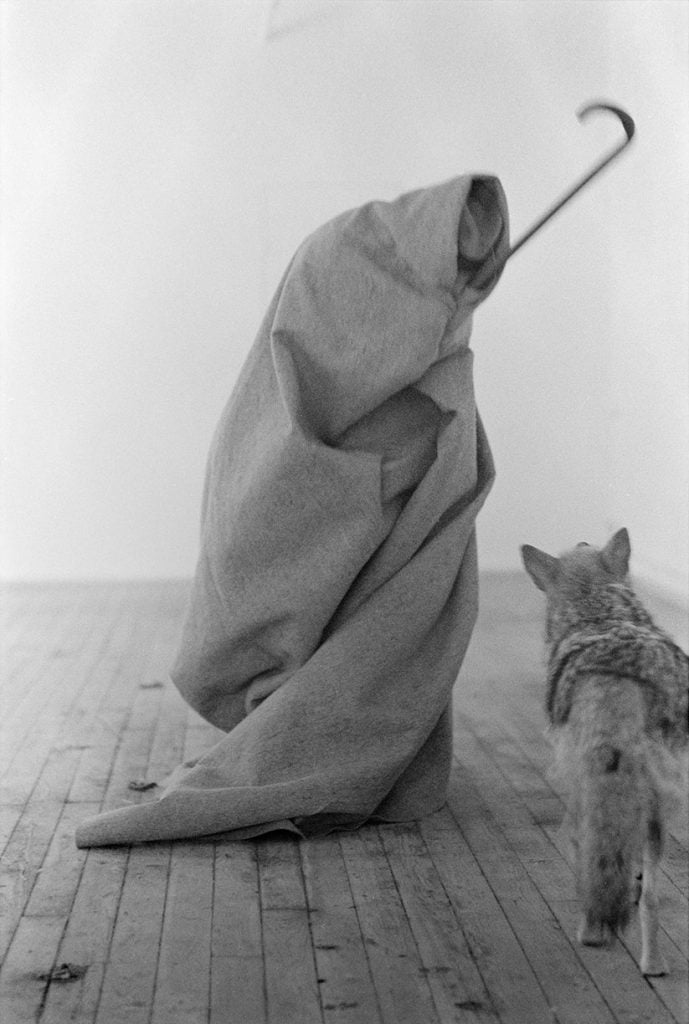Art World
Art Bites: Why Joseph Beuys Spent Three Days Locked Up With a Coyote
The small animal plays an outsize role in various Native American cosmologies.

The small animal plays an outsize role in various Native American cosmologies.

Brian Boucher

I Like America and America Likes Me. That was the seemingly lighthearted title of an inscrutable, very serious, and now legendary 1974 performance by the German artist Joseph Beuys. The artist, who coined the term “social sculpture” to describe his oeuvre, flew into New York’s John F. Kennedy Airport wrapped in felt, and was ferried by ambulance to the René Block Gallery in SoHo. There, he spent business hours over three days behind a fence, solo but for a wild coyote. (It had been brought there through “complicated legal negotiations,” per the New York Times.)
The show ran “with minimal prior announcement,” according to a later review in the same paper, whose critic John Russell wrote that “Nobody who witnessed this peculiar pas de deux will ever forget it.”
A bed of straw occupied one corner, and Beuys was supplied with felt blankets, copies of the Wall Street Journal delivered daily, a flashlight that was always on, and a water dish for the animal. Beuys copied the coyote, roaming when it roamed, resting when it rested. When the artist struck a note on a triangle, a gallery attendant played a loud recording of industrial turbines.
Beuys repeated symbolic actions in an attempt to communicate with the animal, throwing his leather gloves at it or wrapping himself in the blanket with only a shepherd’s staff poking out. Though the coyote was frisky at moments—photos show it yanking on Beuys’s felt blanket with its teeth, and it reportedly chewed up one of his gloves—they apparently came to a detente. One photo even shows the two of them lying side by side in the bed of straw, looking out the window, for all the world like best buds.
Those indispensable photos and videos were shot by his collaborator Caroline Tisdall.
Now, on the occasion of the piece’s 50th anniversary in May, Letter16 Press, of Miami, has brought to light previously unpublished photos of the performance by artist Stephen Aiken, in the book An Artist, a Coyote, and a Cage: Joseph Beuys in New York 1974. Aiken had happened upon Beuys’s “action,” which took place on Memorial Day weekend, which the German dealer had chosen unaware that many New Yorkers would be traveling. “Whether Beuys is pulling his felt blanket taut around him or jauntily waving to Aiken’s camera lens, it’s impossible to look away,” wrote Letter16 co-founder Brett Sokol in the book’s foreword. The book also includes previously unseen photos of Beuys at a standing-room-only speaking engagement at the New School a few months before the coyote piece.
Also known as “Coyote,” the piece’s full title may have referred to the longstanding slogan for 7Up—“You like it. It likes you”—as Arts Magazine critic Joseph Dreiss pointed out. The nation was in the throes of the deeply divisive Vietnam War and riven with class and racial divisions, and the mutuals indicated in the title may have suggested a need for care in divided times. They may also have reflected, Dreiss wrote, “an awareness of the sinister agreeability with which America welcomes foreigners to her shores.”
Critics were divided, with Russell respectful but Dreiss seemingly skeptical, writing, “The whole thing was really quite irregular.” He called the performance “ambiguous but not meaningless,” saying it partook of Beuys’s own highly personal language.
For example, felt was a symbolically nurturing material for the artist and connected to his own origin myth, in which, after being shot down as a World War II fighter pilot in the Crimea, he was wrapped in fat and felt by a Tatar tribesman in order to keep him alive.

Stephen Aiken’s previously unpublished photograph of Joseph Beuys’s action I Like America and America Likes Me (1974), published in a forthcoming book from Letter16 Press.
Animals also played key roles in his performances (PETA would probably blow the whistle today). For example, for his first gallery solo, in 1965, he covered his face in honey and gold leaf and, surrounded by drawings hanging on the walls, cradled and whispered to a deceased member of the family Leporidae for the piece How to Explain Pictures to a Dead Hare.
Crucially, it wasn’t only Beuys’s language that was being spoken, since the coyote is a significant deity in various Native American belief systems, a “subversive power,” as Tisdall told the Times, that was reduced to the status of a trickster after the invasion of white people. In fact, as National Geographic writes, “coyotes have been subject to a pitiless war of extermination by ranchers and government agencies alike.”
At the performance’s conclusion, Beuys was transported back to JFK just the way he had come, via stretcher and ambulance, and without ever touching the ground, so that the only surface he trod on was the turf he shared with the coyote.
The piece has had a long afterlife. When Block closed up his Berlin location five years later, the space was dismantled and some of the wreckage sent to New York, to be displayed alongside remnants of the 1974 performance, such as the staff Beuys carried and the felt hat he wore, as well as strands of hair from himself and the animal. The resulting piece, Aus Berlin: Neues vom Kojoten, or From Berlin: News from the Coyote, is now in the collection of the Dia Art Foundation.
And the piece lives on further, in a way Beuys probably wouldn’t have imagined: the English band the 1975 included a song, “I Like America and America Likes Me,” on its 2018 record A Brief Inquiry into Online Relationships.
In a 1979 review, the Times’s Russell would write that Beuys was “at the very least a valuable absurdity in a world that is locked into the status quo.” Fifty years on, division seems ever more the status quo, and Beuys’s absurdity, which saw him befriend an animal mythologized by natives but subjected to slaughter by whites, seems all the more valuable.
What’s the deal with Leonardo’s harpsichord-viola? Why were Impressionists obsessed with the color purple? Art Bites brings you a surprising fact, lesser-known anecdote, or curious event from art history. These delightful nuggets shed light on the lives of famed artists and decode their practices, while adding new layers of intrigue to celebrated masterpieces.